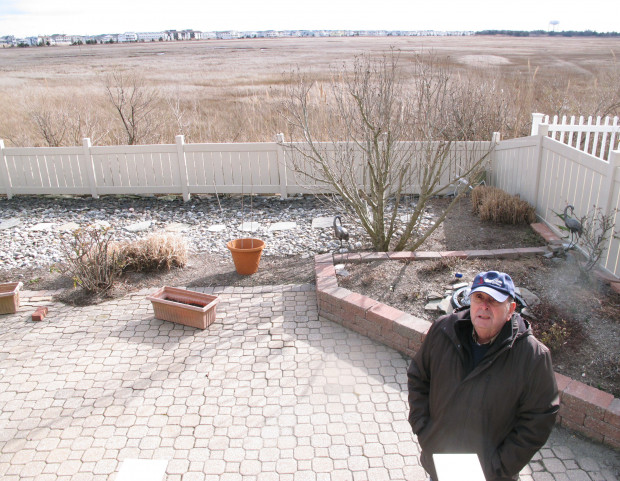Sea level rise to cause chronic flooding in Delaware Bay and Jersey Coast, scientists say
-
Catalina Jaramillo/WHYY

Wayne Parry / AP Photo
This Feb. 16, 2017 photo shows Marty Mozzo in his back yard in Ocean City N.J. on the edge of a back bay wetlands. When he and his wife were considering buying the house, they looked at a small trickle of water in the distance and wondered if the property would flood, deciding the water was too far away to pose a danger. Within weeks, their house was surrounded by flood waters.
About 170 coastal communities across the nation will experience chronic flooding 20 years from now, disrupting people’s life and daily routines, and forcing residents of those communities to make difficult and expensive decisions, according to a study out this week by the Union of Concerned Scientists.
In a moderate sea level rise scenario, cities and towns along the Delaware Bay and New Jersey coastlines could see between 15 and 40 percent of their land flooded at least 26 times each year by 2030.
“It’s horrifying,” Suzanne Hornick, chairperson of the Ocean City, NJ Flooding Committee. “My house would be under water in 40 years.”
Hornick is already in a bad situation. She says her home floods about 10 times a year, and she has to fix her basement walls and garage door at least every two years. Every time it rains, Hornick says she moves her car and parks it two or three blocks from her house, so it doesn’t get inundated with water. When winter storm Jonas hit the U.S. in 2016, she couldn’t leave her home for four days.
“It’s insane, and it’s very expensive,” ” Hornick says. “And it’s getting worse and more frequent.”
The interactive Union of Concerned Scientists’ report “When Rising Seas Hit Home,” allows residents to view how their towns may be impacted under different sea level rise scenarios. For parts of the Delaware Bay, it shows that by 2060, the number of communities effected by tidal driven coastal flooding will double. By 2100, it doubles again, impacting counties further north along the Bay including highly populated areas of Wilmington, Del., Camden, N.J., and even Burlington, N.J.
New Jersey Audubon Society’s David S. Mizrahi said the flooding could have a huge impact in coastal habitats.
“It’s already happening,” said. “We’re pushing wildlife into a corner. It’s not the kind of situation that you would like.”
Mizrahi said they’re already seeing declines of species, impacting the biodiversity in dunes and tidal marshes. The Piping plover, the American oystercatcher and colonial nesting waterbirds are already threatened, along with the rufa red knot that attracts thousands of visitors every year.
“We [humans] are not immune to that either,” Mizrahi said. “As we lose natural barriers such as marshlands, our population is going to be more and more affected.”
According to the study, if carbon emissions continue to rise and sea level rise reaches six feet by 2100, “the same areas of Cape May that were flooded by Hurricane Sandy’s storm surge would be inundated more than 26 times or more per year, or every other week on average.”
By identifying when flooding will become disruptive, the study allows communities to get prepared.
“Hundreds of communities along the coasts, from Maine to Washington State, will be forced to make difficult choices about whether and how much to invest in flooded areas versus when to retreat from them,” the study says.
Hornick, from Ocean City, said she started the flooding committee five years ago because she didn’t want to move.
“I love my house, I love my island,” Hornick said. “I don’t want to move out, I want to make it better.”
Hornick said the group has about 1,000 members. Some have property valued over $500,000. Currently, the group is trying to stop continued development of the island, and increase the number of permeable surfaces.
The Union of Concerned Scientists reports that if communities act now and the U.S. meets the Paris Agreement goals, about 380 communities could avoid chronic inundation.
















